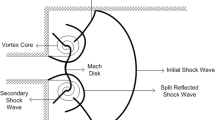Abstract
Shock wave motion is important in many areas of engineering like blast wave modeling, aeronautical design, medical applications, etc. Previous works mostly emphasized on sharp geometry responsible for flow separation immediately. In present study, shock diffraction over round corner is investigated solely and the intricate flow features are summarized. Numerical simulations are performed using Finite Volume Method. The rounded geometry requires laminar viscosity model due to continuous changes of the orientation. The unsteady flow field is designed to have an understanding appropriate to the test cases in real practice. Shear layer, vortex generation, secondary and recompression shock waves, etc. are clearly investigated. Induced flow velocity reaches supersonic level after being passed by the convergent-divergent passage and thereafter shocked to gets reduced in magnitude. Internal terminating shock compresses the flow to a relatively higher pressure to curve the shear layer in opposite direction. Beginning of separation and change in curvature of shear layer indicates more vortex strength than the primary vortex core.





Similar content being viewed by others
References
B. Skews, The perturbed region behind a diffracting shock wave. J. Fluid Mech. 29, 705–719 (1967)
B. Skews, C. Law, A. Muritala, S. Bode, Shear layer behaviour resulting from shock wave diffraction. Exp. Fluids 52, 417–424 (2012)
R. Hillier, M. Netterfield, Computation of shock wave diffraction and unsteady shock-boundary layer interaction, In: Proc 17th Int symp on shock waves and shock tubes. AIP pp. 228–233 Waves (1990), 1: 89–98.
R. Hillier, Computation of shock wave diffraction at a ninety degrees convex edge. Shock Waves 1, 89–98 (1991)
M. Sun, K. Takayama, The formation of a secondary shock wave behind a shock wave diffracting at a convex corner. Shock Waves 7(5), 287–295 (1997)
M. Sun, K. Takayama, A note on numerical simulation of vortical structures in shock diffraction. Shock Waves 13, 25–32 (2003)
M. Sun, K. Takayama, Vorticity production in shock diffraction. J. Fluid Mech. 478, 237–256 (2003)
T.V. Bazhenova, L.G. Gvozdeva, M.A. Nettleton, Unsteady interactions of shock waves, progress in aerospace. Sci 21, 249–331 (1984)
G. Ben-Dor, Shock wave reflection phenomena (Springer-Verlag, 1992)
M.S. Liou, C.J. Steffen Jr., A new flux splitting scheme. J. Comput. Phys. 107, 23–39 (1993)
J.D. Anderson, Modern compressible flow: with historical perspective. Series in aeronautical and aerospace engineering, 3rd edn. (McGraw-Hill, New York, 2003)
M.A. Jinnah, K. Takayama, Numerical measurements of turbulent length scales in shock/turbulence interaction. J. Inst. Eng. Ser. C. 93(1), 75–81 (2012)
M.A. Jinnah, Numerical simulation of shock induced turbulence in a nozzle flow. J. Inst. Eng. India Ser. C 94(3), 229–237 (2013)
Quinn, M.K. Shock diffraction phenomena and their measurement, A thesis submitted to the university of Manchester for the degree of doctor of philosophy in the faculty of engineering and physical sciences (2013).
F. Gnani, K.H. Lo, H. Zare-Behtash, K. Kontis, Experimental investigation on shock wave diffraction over sharp and curved splitters. Acta Astronaut. Astronaut. 99, 143–152 (2014)
S. Dey, T. Murugan, D. Chatterjee, Blast wave interaction with generic objects and the measurement of blast wave reattachment distances. J. Inst. Eng. India Ser. C 101, 747–760 (2020)
Acknowledgements
This paper is a revised and expanded version of an article entitled ‘Computational Study of Shock Diffraction over Rounded Corners’ presented in ‘2nd International Conference on Energy Resources and Technologies for Sustainable Development’ held at IIEST Shibpur, Howrah, India during 27-28 April 2023.
Funding
The authors declare that no funds, grants, or other support were received during the preparation of this manuscript.
Author information
Authors and Affiliations
Contributions
All authors contributed to the study and design. Material preparation, data collection and analysis were performed by all authors. The first draft of the manuscript was written by Debiprasad Banerjee and all authors commented on previous versions. All authors read and approved the final manuscript.
Corresponding author
Ethics declarations
Conflict of interest
The authors declare that they have no known competing financial interests or personal relationships that could have appeared to influence the work reported in this paper.
Additional information
Publisher's Note
Springer Nature remains neutral with regard to jurisdictional claims in published maps and institutional affiliations.
Rights and permissions
Springer Nature or its licensor (e.g. a society or other partner) holds exclusive rights to this article under a publishing agreement with the author(s) or other rightsholder(s); author self-archiving of the accepted manuscript version of this article is solely governed by the terms of such publishing agreement and applicable law.
About this article
Cite this article
Banerjee, D., Halder, P. Numerical Analysis of Shock Diffraction over Rounded Corner. J. Inst. Eng. India Ser. C (2024). https://doi.org/10.1007/s40032-024-01049-9
Received:
Accepted:
Published:
DOI: https://doi.org/10.1007/s40032-024-01049-9




